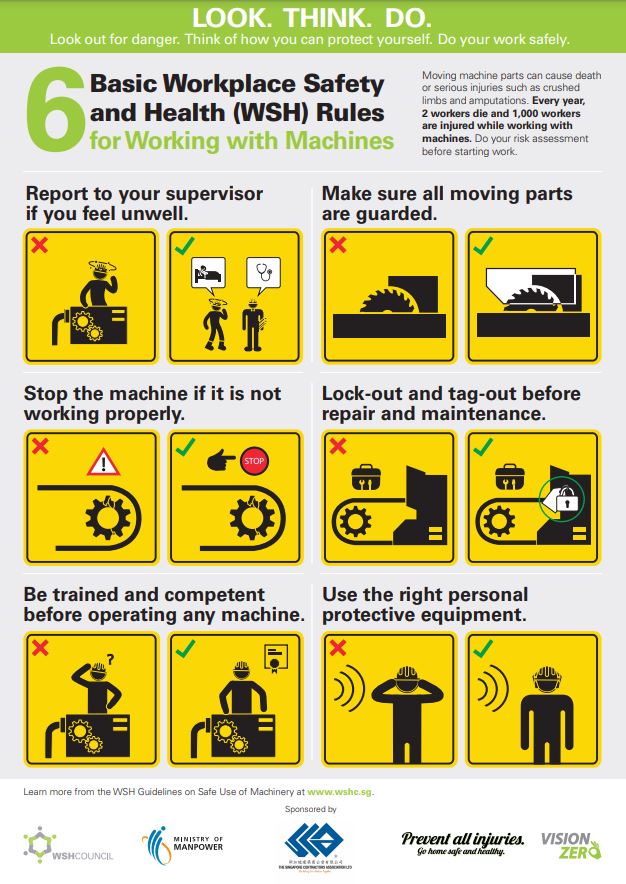Workplace Safety and Health (WSH) Rules for Working with Machines in Singapore
Introduction
In Singapore, workplace safety is governed by the Workplace Safety and Health Act (WSHA), which ensures that workers are protected from machinery-related hazards. Risks such as entanglement, crushing, electrical shocks, and exposure to hazardous energy can lead to severe injuries or fatalities.
To prevent such incidents, companies must comply with safety guidelines from the Ministry of Manpower (MOM), WSH Council, and Singapore Standards (SS). In this blog, we will explore the essential safety rules for working with machines and how they contribute to a safer work environment.
1. Training and Competency
Proper training is the foundation of workplace safety.
✅ Mandatory Training: Workers must receive machine-specific training, covering hazard identification, safe operation, and emergency response. Employers are legally required to provide this under the WSHA.
✅ Authorization: Only trained and authorized personnel should operate or maintain machinery.
✅ Refresher Courses: Regular training updates are essential to keep up with technological changes and new safety protocols.
2. Machine Guarding
Machine guarding is a critical measure to prevent accidental contact with dangerous parts.
✅ Install Safeguards: Use physical barriers, interlocks, or light curtains in accordance with SS 528:2016 – Safeguarding of Machinery.
✅ No Tampering: Never remove or bypass safety guards, even temporarily. If a guard is damaged, report it immediately.
3. Lockout/Tagout (LOTO) Procedures
LOTO procedures help prevent accidental machine start-ups during maintenance.
✅ Isolate Energy Sources: Follow SS 573:2021 – Lockout/Tagout to safely disconnect electrical, hydraulic, or pneumatic energy.
✅ Verification: Always test the machine after applying LOTO to ensure zero energy before starting any maintenance work.
4. Personal Protective Equipment (PPE)
Using the right PPE can significantly reduce the risk of injuries.
✅ Mandatory PPE: Depending on the task, workers should wear safety goggles, gloves, ear protection, and steel-toe boots.
✅ Employer Responsibility: Employers must provide properly fitted PPE, and employees must wear it consistently.
5. Regular Inspections and Maintenance
Preventive maintenance keeps machines in good working condition and minimizes risks.
✅ Pre-Use Checks: Always inspect machinery for defects before operation.
✅ Scheduled Maintenance: Follow manufacturer guidelines for periodic maintenance and document all inspections to comply with WSH regulations.
6. Risk Assessments
Risk assessments help identify and mitigate workplace hazards.
✅ Identify Hazards: Conduct risk assessments in accordance with WSH (Risk Management) Regulations.
✅ Mitigate Risks: Implement engineering controls, administrative measures, or PPE to minimize risks.
7. Emergency Preparedness
Being prepared for emergencies can save lives.
✅ Clear Protocols: Establish emergency shutdown procedures, evacuation routes, and first-aid measures.
✅ Access to Equipment: Fire extinguishers and emergency stop buttons should be easily accessible and regularly checked for functionality.
8. Incident Reporting
Reporting workplace incidents helps prevent future accidents.
✅ Immediate Reporting: Report any near-misses, injuries, or machine malfunctions to supervisors immediately.
✅ Investigation: Employers should investigate incidents thoroughly and implement corrective actions as required by MOM.
9. Housekeeping
A clean workplace is a safer workplace.
✅ Clutter-Free Zones: Keep work areas clean and organized to prevent slips, trips, and falls.
✅ Proper Waste Disposal: Dispose of flammable materials and oily rags safely to reduce fire hazards.
10. Compliance with Singapore Standards
Following Singapore Standards (SS) ensures legal and safety compliance.
✅ Adherence to SS: Employers must comply with standards such as SS 506:2020 for occupational noise control and other relevant safety regulations.
✅ Penalties for Non-Compliance: Violating WSHA regulations can result in fines up to $500,000 or imprisonment.
Conclusion
Workplace safety is a shared responsibility between employers and employees. Employers must ensure proper training, provide safe equipment, and maintain a hazard-free environment. Employees, in turn, should follow safety protocols, wear PPE, and stay vigilant.
By integrating these WSH safety rules, workplaces can prevent accidents, improve productivity, and foster a strong safety culture.
For more details, refer to MOM’s WSH Council publications and Singapore Standards (SS). Stay safe and prioritize workplace safety.
👉 Thedaily71 Whatsapp Group - যুক্ত হতে এখানে ক্লিক করুন
👉 Thedaily71 Facebook Page এখানে ক্লিক করুন





























0 মন্তব্যসমূহ